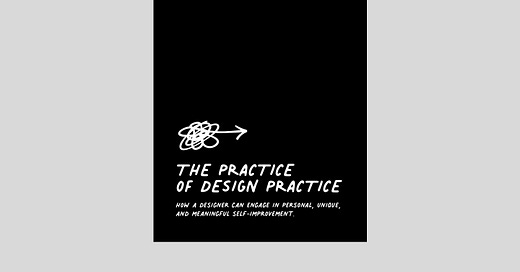The "Practice of Design Practice" book is out now.
I scrapped content that I had written for two months and came up with this idea.
I’m doing pretty well. During my three months of absence, I survived the winter in the Netherlands and finished my book titled 'The Practice of Design Practice.'
In addition to that, I've been exploring some topics and directions for my newsletter this year as a form of long-form writing, and I've also started creating short-form content on Instagram.
Cheers to 2024—I hope it's not too late to say this, considering the first two months were a free trial.
The writing process
I started writing this book eight months ago and announced it in a post as a form of deliberate practice. The main idea was to offer a different perspective on how designers can practice their craft.
However, upon reflecting more on my journey, I realized that I didn’t engage in deliberate practice as much as I thought. Moreover, most of the time, I didn’t stick to what I had planned. I also used to think that learning occurs through the work itself, which I found to be wrong after conducting further research.
Deliberate practice is considered the ideal form of practice. However, I find myself questioning how I can write about something that I don't fully embody. I want this book to reflect my journey.
In the beginning, I hesitated, fearing that other designers might not share the same experiences I had: a lack of structure, feeling stuck and then restarting, trying to integrate practice into a daily work routine, becoming exhausted, and eventually caring less about practice—it was just a mess.
It turned out, I’m not alone. The people I interviewed felt the same way. Maintaining consistency is hard. Feeling motivated all the time is almost impossible.
Then, I revamped the idea of this book from deliberate practice to various practices in general that designers could use to enhance their competencies and confidence. In the first two months, I wrote about deliberate practice, which constitutes 10% of this book. When I switched tracks, I initially felt overwhelmed, but it felt right to me as if I was writing a book that I would read myself whenever I felt stuck and unmotivated.
The book
The Practice of Design Practice is a collection of stories/ideas/insights about how designers could engage in self-improvement as lifelong learners, packed with anecdotes and a bit of science.
I have boiled down more than a decade of my experience, which spans leading learning and development for the Bukalapak design team, teaching various boot camp programs, working in an agency, collaborating within a startup environment, and contributing to a big tech company.
More than that, it's a culmination of my simple observations throughout the ups and downs of my career as a product designer, where I felt stuck and unstuck, through trials and errors, finding new methods to keep up as a designer while raising my two beautiful children.
I believe that every journey to improve as a designer is unique. Each of us has different ways to practice our craft. What works for one person may not necessarily work for another, and what's important is for each individual to find what works for them, even though it may sometimes be scrappy, unstructured, and confusing.
The cause
During the presale, I received money from early supporters, and I believed that I should pass this kindness on to others.
More than that, I have always been discontented with seeing the world burning and unfair, and sometimes I’d ask myself a question: “How can I help others with the skills I have?”
So, I realized this is an opportunity to use what I have and what I can do to help others.
All the initial sales will be 100% donated to the UN World Food Program to help the beautiful souls affected by war right now in Ukraine and Gaza, providing them access to better food and nutrition.
The UN World Food Programme is a 100% voluntarily funded organization. For every $1 you give, 64 cents goes directly to programs supporting hungry people.
Right now, 2 cents is used to process your donation and 6 cents helps run WFP and our programs. 28 cents goes towards raising the next $1 (which under our ten-year plan will fall – averaging out at 22 cents between 2020-2030).Thank you.










